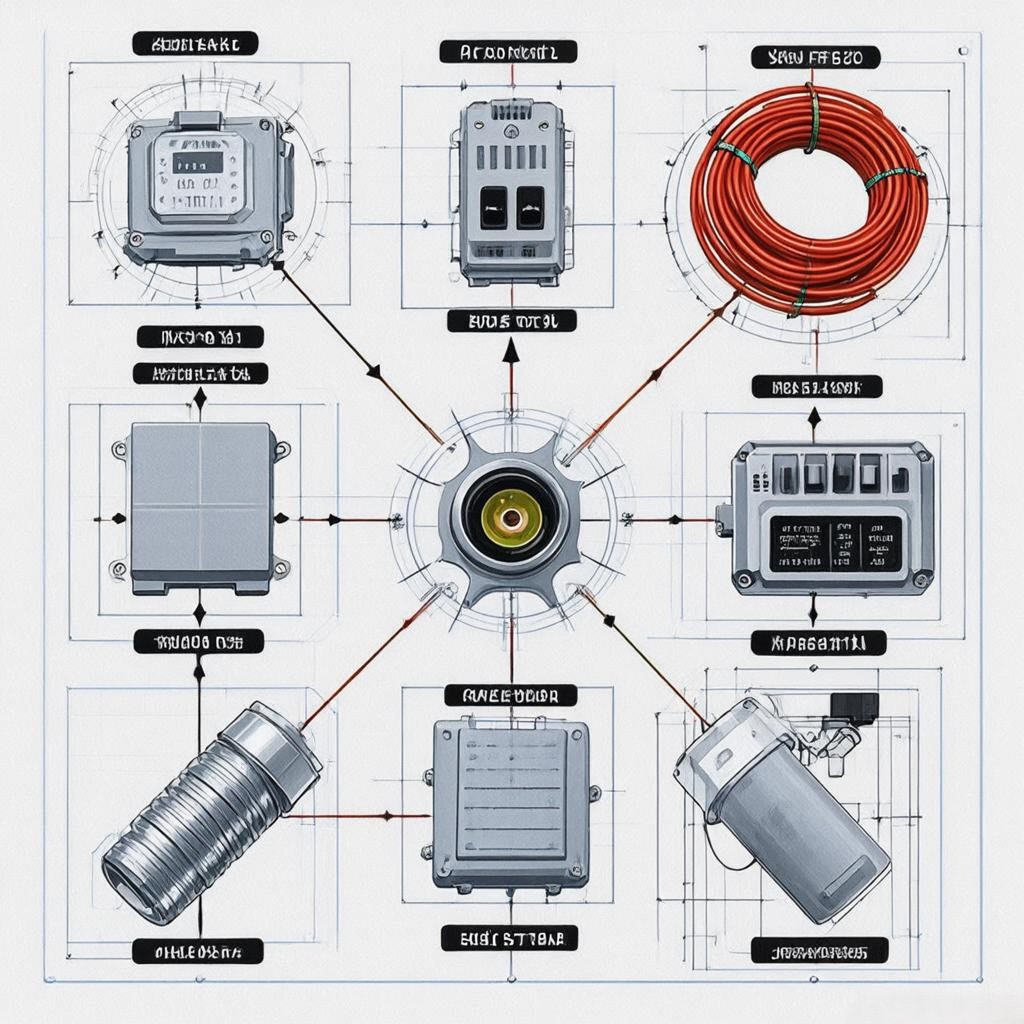In the complex world of vehicle dynamics, pneumatic control valves serve as the unsung heroes that translate driver inputs into precise braking performance. These sophisticated components regulate compressed air flow with surgical accuracy, ensuring safe deceleration across a wide range of operating conditions. This comprehensive technical deep dive explores the engineering marvels behind pneumatic control valves, their critical role in modern braking systems, and how ongoing innovations are shaping their future evolution.




1. Fundamental Principles of Pneumatic Control in Braking
Pneumatic control valves represent the critical interface between a vehicle’s compressed air system and its braking mechanisms. These valves perform several essential functions:
- Pressure modulation: Precisely controlling air pressure delivered to brake chambers
- Flow rate management: Regulating the speed of pressure buildup/release
- System protection: Preventing pressure spikes that could damage components
Technical specifications typically include:
- Operating pressure range: 4-12 bar (58-174 psi)
- Response time: <150ms for full actuation
- Flow capacity: Up to 300 liters/minute depending on valve size
Industry significance: Over 70% of commercial vehicles worldwide rely on pneumatic braking systems where these valves serve as the primary control mechanism.
2. Types of Pneumatic Control Valves and Their Applications
Modern braking systems employ several specialized valve configurations, each optimized for specific performance requirements:
2.1 Relay Valves (Quick Release/Supply Valves)
- Function: Amplifies pneumatic signals while maintaining system pressure
- Key features:
- Dual-port design for simultaneous supply and exhaust
- Spring-loaded pistons for rapid response
- Pressure-balanced construction for consistent performance
Applications: Heavy-duty trucks, buses, and trailers where fast brake application/release is critical
2.2 Proportioning Valves
- Function: Adjusts pressure distribution between front and rear brakes
- Advanced features:
- Load-sensing capabilities via height sensors
- Dynamic pressure adjustment based on vehicle speed
- Fail-safe default to full braking if system faults detected
Technical highlight: Modern proportional valves can adjust pressure within ±2% accuracy across varying loads.
2.3 Quick Release Valves
- Function: Rapidly exhausts brake chamber pressure for quick release
- Design elements:
- Tandem piston configuration for balanced exhaust
- Large flow area minimizes pressure drop
- Internal dampening prevents brake chatter
Performance metrics: Typical exhaust time <0.3 seconds for complete pressure release
2.4 Foot Control Valves (Brake Pedal Valves)
- Function: Converts driver pedal input into proportional air pressure
- Advanced versions:
- Dual-circuit designs for redundancy
- Pressure sensors for electronic brake force distribution
- Adjustable pedal feel through adjustable springs
Ergonomic design: Modern valves incorporate progressive resistance curves matching natural foot movement patterns.
3. Advanced Functional Features in Modern Pneumatic Valves
Contemporary pneumatic control valves incorporate sophisticated technologies to enhance braking performance:
3.1 Electronic Control Integration
- Solenoid-modulated valves: Electrically controlled pilot valves for precise pressure adjustment
- CAN bus communication: Receives braking commands from vehicle ECUs
- Closed-loop feedback: Pressure sensors verify actual vs. target pressure
System benefits: Enables features like adaptive cruise control braking and collision avoidance systems.
3.2 Pressure Management Innovations
- Dynamic pressure compensation: Adjusts for temperature-induced air density changes
- Load-sensing algorithms: Modifies braking force based on real-time weight distribution
- Pulse-width modulation: Smooth pressure transitions prevent wheel lockup
Technical achievement: Some advanced valves achieve pressure control accuracy within ±0.5 psi across the entire operating range.
3.3 Diagnostic and Prognostic Capabilities
- Self-test routines: Automatically verifies valve operation during startup
- Leak detection: Monitors air flow patterns for early fault identification
- Predictive maintenance: Uses historical data to forecast component lifespan
Industry compliance: Meets ISO 26262 ASIL C functional safety requirements for electronic brake systems.
4. System Integration and Architectural Considerations
Pneumatic control valves don’t operate in isolation—they’re integral components of complex braking ecosystems:
4.1 Air Brake System Architecture
- Primary circuit: Supplies air to rear brakes through relay valves
- Secondary circuit: Controls front brakes with proportioning valves
- Parking brake circuit: Independent path with spring-applied valves
Redundancy features: Dual-circuit designs ensure continued braking capability even with partial system failure.
4.2 Integration with Other Vehicle Systems
- ABS integration: Valve modulation synchronizes with anti-lock braking pulses
- Traction control: Selective wheel braking via valve actuation
- Adaptive cruise control: Gradual pressure adjustments for smooth deceleration
System synergy: Modern vehicles use pneumatic valves as part of comprehensive safety networks, not isolated components.
4.3 Electropneumatic Hybrid Systems
- Combination valves: Merges traditional pneumatic operation with electronic controls
- Fail-operational design: Maintains basic braking even with electronic failures
- Gradual transition: Smooth handoff between electronic and pneumatic control
Market trend: Electropneumatic systems growing at 6.8% CAGR as vehicles add more automated functions.
5. Design Challenges and Engineering Solutions
Developing reliable pneumatic control valves requires overcoming significant technical hurdles:
5.1 Precision in Harsh Environments
- Temperature compensation: Specialized seals maintain performance from -40°C to +120°C
- Vibration resistance: Reinforced housings withstand 5-2000Hz vibrations
- Contamination protection: Multi-stage filtration prevents valve clogging
Innovation highlight: Some valves now use self-cleaning piston designs that expel contaminants during operation.
5.2 Pressure Control Accuracy
- Flow modeling: Computational fluid dynamics (CFD) optimizes internal passages
- Material selection: Hardened alloys resist wear from high-speed air flow
- Tight manufacturing tolerances: ±0.01mm precision in critical components
Quality metric: Leading manufacturers achieve <1% pressure deviation across 1 million cycle tests.
5.3 Electromagnetic Compatibility (EMC)
- Shielded solenoids: Prevents radio frequency interference
- Filtered power supplies: Eliminates voltage spikes affecting electronic controls
- Grounding schemes: Prevents ground loops that could cause erratic operation
Regulatory compliance: Meets ISO 7637-2 and ISO 11452-2 EMC standards for automotive electronics.
6. Testing and Validation Protocols
Ensuring pneumatic valve reliability requires rigorous testing procedures:
6.1 Performance Testing
- Pressure cycling: 1,000,000+ cycles between 0-12 bar
- Flow rate verification: Mass flow meters check performance at all operating points
- Temperature cycling: -40°C to +120°C rapid transitions
6.2 Environmental Durability
- Salt spray exposure: 1,000 hours minimum for corrosion resistance
- Dust ingress testing: IP67 rated enclosures prevent contamination
- Humidity resistance: 95% RH at 40°C for extended periods
6.3 Functional Safety Validation
- Fault injection testing: Simulates electronic control failures
- Fail-safe verification: Confirms proper operation under all fault conditions
- Diagnostic coverage analysis: Ensures 99% fault detection capability
Certification: Compliance with ISO 26262 ASIL B for electronic brake components.
7. Market Trends and Future Developments
The pneumatic control valve market is undergoing significant transformation:
7.1 Electrification and Autonomous Driving
- Full electronic replacements: Electrically actuated valves replacing pneumatic components
- AI-based predictive control: Machine learning algorithms optimize pressure modulation
- Vehicle-to-everything (V2X) integration: Shares braking status with surrounding vehicles
7.2 Sustainable Design Initiatives
- Energy recovery systems: Captures exhaust air energy for auxiliary functions
- Biodegradable lubricants: Environmentally friendly valve operation
- Recyclable materials: End-of-life component recycling programs
7.3 Advanced Manufacturing Techniques
- 3D-printed components: Complex geometries impossible with traditional machining
- Digital twin technology: Virtual testing reduces development time
- Automated assembly: Robotic precision ensures consistent quality
Research frontier: Development of self-healing valve seals that automatically repair minor leaks without service intervention.
8. Case Studies: Real-World Implementation
Case Study 1: Premium Truck Brake System Upgrade
A European manufacturer implemented electropneumatic valves in their heavy-duty trucks, achieving:
- 15% improvement in brake response time
- 30% reduction in air compressor workload
- 25% fewer warranty claims related to braking performance
Case Study 2: Autonomous Bus Fleet Deployment
A Level 4 autonomous transit system deployed smart pneumatic valves, resulting in:
- 99.998% braking command execution reliability
- 200ms faster emergency stop initiation
- Seamless integration with AI-based collision avoidance systems
Conclusion: The Precision Heart of Braking Systems
Pneumatic control valves may work behind the scenes, but their impact on vehicle safety and performance is profound. As braking systems evolve toward greater automation and electrification, these components continue adapting to meet new challenges:
Key takeaways:
- Pneumatic valves have transitioned from simple mechanical switches to sophisticated electronic controllers
- Modern designs prioritize precision, reliability, and diagnostic capabilities
- Integration with vehicle networks enables coordinated safety functions
- Future developments will focus on full electrification and autonomous compatibility
Final thought: In the quest for safer, more efficient transportation, pneumatic control valves remain the critical link between driver intent and vehicle response—quietly ensuring every stop happens precisely when and how it should.
Call to Action
🔧 Upgrading your brake system?
⚙️ Consider electropneumatic valve options for improved performance
📊 Request comparative analysis of traditional vs. electronic valve systems
#AutomotiveEngineering #BrakeTechnology #Pneumatics #CommercialVehicles #ADAS #FunctionalSafety #SmartMobility #FutureOfTransportation



